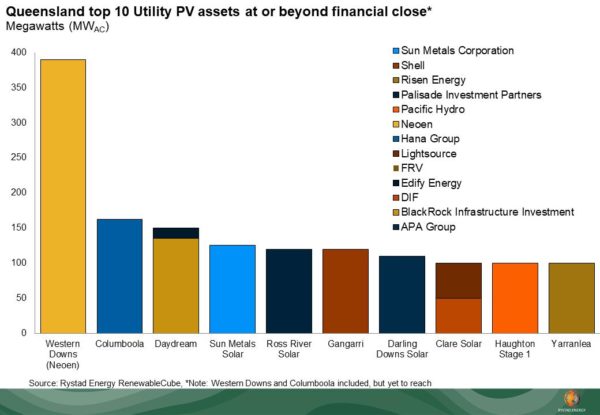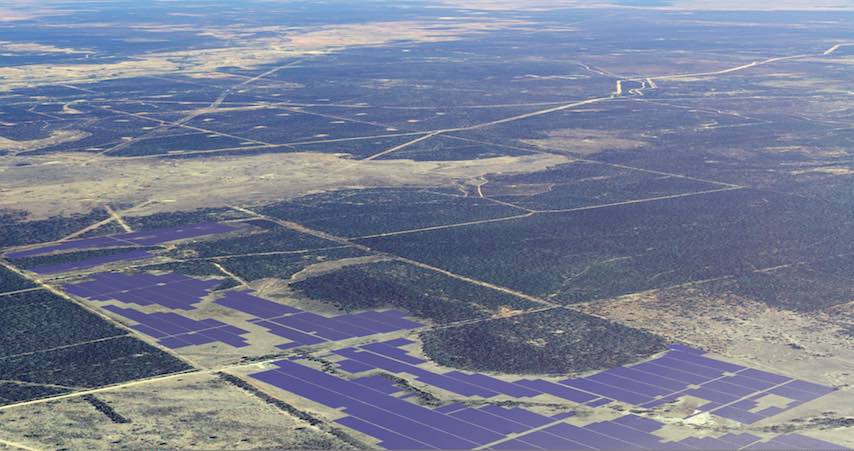UK solar and energy storage developer Luminous Energy has agreed to sell its largest PV project to date and its first in Australia, the 162MWac (203MWdc) Columboola Solar Farm, to South Korea-based Hana Financial Investment. The sale follows on from a recent signing of a power purchase agreement with Queensland government-owned utility CS Energy for 100% of the project’s output.
The Columboola project will be built by Sterling and Wilson near Miles in Queensland’s Western Downs and will power the equivalent of 100,000 average homes. It will use bifacial solar panels and single-axis trackers to boost energy generation to 450 GWh each year. Construction is scheduled to start this month, creating 400 jobs, and due to be completed by the end of next year.
Once operational, the Columboola Solar Farm will export electricity under the PPA with CS Energy, which will on-sell all of its output to its large commercial and industrial retail customers, including Griffith University, Central Queensland University, and Queensland University of Technology. To date, CS Energy and Queensland’s two other publicly-owned generators, CleanCo and Stanwell, have supported or own 1900 MW of renewable energy generation.
CS Energy CEO Andrew Bills said the utility was responding to the needs of large energy users like the universities by developing tailored solutions that met their needs in terms of energy usage, decarbonization, and energy management. “Through this PPA CS Energy continues to diversify our portfolio and offer our retail customers renewable generation as part of their energy supply,” Bills said.
Jobs boost
Queensland Energy Minister Dr Anthony Lynham said on Friday that financial close on the Columboola project and its concurrent sale to Hana underpin the state’s economic plan for post-Covid recovery and affordable, reliable energy supply. “That plan includes investing in traditional infrastructure and supporting the renewables industry because that supports jobs,” he said.
As part of the state’s economic recovery plan, the Palaszczuk Government has recently committed $145 million for Renewable Energy Zones in north, central and south-west Queensland. Acting on the concentrated benefits of REZs, Queensland hopes to provide the much-needed, carefully-planned, additional electricity transmission infrastructure in designated areas as well as streamline the development of new renewable energy projects, support for the deployment of new energy storage and work to attract new industries to these zones.
Located in the south-west REZ, the Columboola Solar Farm takes Queensland’s tally of financially committed or operational large-scale renewable energy projects to 41 since 2015, according to the government data. “Queensland is forecast to reach 20 per cent renewable generation this year and projects like this continue to drive us to our target of 50 per cent by 2030,” Lynham said.
Aiming at the target
Presently, renewable energy accounts for just 14% of the state’s electricity mix – the lowest in Australia. While Queensland boasts the biggest pipeline of utility-scale PV, wind and storage projects among Australian states and territories, the projects are often held back by grid bottlenecks and exposed to the risk of radical curtailment, including 1 GW of solar projects in the north of the state, for reasons such as network capacity and system strength.
To meet its 50% RE target, Queensland will need around 5500 MW of large-scale renewable energy generation between now and 2030, which could attract almost $10 billion of private investment and create more than 10,000 jobs, the Clean Energy Council (CEC) calculates. Investors stand at the ready, with around 17,000 MW of new large-scale renewable energy projects with secured planning approvals.
“However, while the state has made significant strides during the past four years in raising the level of clean energy generation off a low-base, investment in Queensland is stagnating,” CEC chief Kane Thorton recently warned. “This is in large part due to inadequate transmission capacity, the many complex hurdles for connecting new generators and increasing constraints being placed on many operating solar and wind farms. The lack of long-term federal energy policy has also played a material role in this slow down.”
According to the CEC data, only three large-scale projects were financially committed in the 18 months between January 2019 and June 2020. This compares with eight projects being financially committed during the 2018 calendar year and 19 projects in the 2017 calendar year. Following the latest announcement, the Columboola Solar Farm has become the state’s second-largest project to reach financial close, following Neoen’s massive Western Downs solar farm, as shown in Rystad Energy’s graph below.

For Luminous Energy, the sale of the Columboola plant, which was developed together with PwC Australia, represents a significant milestone. The developer plans to use the project as “a springboard to consolidate growth” in its existing markets while eyeing up new ones. To date, Luminous Energy has initiated 1.2 GW of new solar and storage projects across the UK, USA, Australia and Chile, with a combined value of AU$1.6 billion
“Australia is a major market in the global solar revolution and the country’s solar industry has huge potential,” Jolyon Orchard, CEO of Luminous Energy said. “This project showcases how innovation can help secure an impactful and prestigious PPA, such as that with CS Energy, and interest from a world-class investor, such as Hana Financial Investment. It supports our vision to accelerate the growth of the global solar industry by generating low cost, reliable electricity while respecting the natural environment.
This content is protected by copyright and may not be reused. If you want to cooperate with us and would like to reuse some of our content, please contact: editors@pv-magazine.com.









By submitting this form you agree to pv magazine using your data for the purposes of publishing your comment.
Your personal data will only be disclosed or otherwise transmitted to third parties for the purposes of spam filtering or if this is necessary for technical maintenance of the website. Any other transfer to third parties will not take place unless this is justified on the basis of applicable data protection regulations or if pv magazine is legally obliged to do so.
You may revoke this consent at any time with effect for the future, in which case your personal data will be deleted immediately. Otherwise, your data will be deleted if pv magazine has processed your request or the purpose of data storage is fulfilled.
Further information on data privacy can be found in our Data Protection Policy.